The History of Hathern Band
Contents
- Introduction
- First band
- Second band
- Rivalry
- Amalgamation, WW1 and WW2
- Post war
- 1960 and 1970
- 1980 and 1990
- 2000
- 2010
- 2020
For a list of historical contest results please see the Results section. Numerous photographs can be found on our Facebook page.
Introduction
The history of Hathern Band can be traced back to the 19th Century, with a band formed in 1856, according to an obituary notice reporting the death in 1900 of a founder member and former bandmaster, William Widdowson. Towards the end of the 19th Century a second band was formed, and Hathern, with a population of only around 1200 at the turn of the century, must surely have been unique in supporting two brass bands. The present band derives from an amalgamation of these two in 1917.
First band
The earliest record we have of a brass band in the village is of Whit Week, 1860. On Whit Monday, 28 May, the band played at the Oddfellows anniversary, apparently in Nottingham, and on Whit Tuesday accompanied the Long Whatton Young Men’s Club to a church service. The next engagement we are aware of was at Hathern’s Temperance Festival on 20 July 1860.
There followed a couple of notable engagements. In 1863 the band played at “Hathern’s wedding of the year” when Richard Cheatle, who was in his eighties, married Anne Ratcliffe a widow of 45. Over 1000 people attended and this was a less than temperate affair as it was reported that the crowd paraded around the public houses and became “more merry than wise.”
Somewhat later, on the Monday of Wakes week, 15th July 1867, a procession to celebrate the first anniversary of the Court Marquis of Hastings Ancient Order of Foresters took place and included Hathern Band. The anniversary procession became a regular feature of Wakes week. By the sixth anniversary, in 1872, the parade included ‘The Hathern Brass Band in full uniform who played in good style’. The parades were usually led, not by the band, but by two members of the Order on horse-back dressed as Robin Hood and one of his merry men. In 1872 these were ‘brothers T Swift as Robin Hood and J Dutton as Will Scarlet on two iron-grey steeds’.

Hathern Brass Band c.1879
Thos Bowley, Sam Mitchell, Wm Widdowson, Sarson Morris, Thos Miller (snr.), Henry Mitchell, Thomas Fisher, Wm Tollington, Wm Warren, James Mitchell, Wm Mitchell, Chas Moody.
The Hathern Brass Band of c.1879 and of 1886 are shown in the first and second photographs respectively. The first bandmaster we are aware of was the aforementioned William Widdowson who, in a newspaper of May 1879, was thanking contributors to the new military uniform.
The band was intimately involved with the social life of the village which included many parades, concerts, both indoors and open air and dances throughout the year. Engagements at neighbouring villages were also undertaken when transport was usually a local farmer’s horse and brake.

Hathern Brass Band 1886 (date on photograph)
?, Chas Moody, ?, ?, ?, Thos Miller (snr), ?, ?, ?, ?, Wm Mitchell, Thos Bowley, Thos Fisher
The major social events of the end of the century were of course the Jubilee celebrations of Queen Victoria. For the Golden Jubilee in June 1887, the Hathern Brass Band took part in the Loughborough celebrations, the highlight of which was a parade which included five brass bands. At Hathern, in the meantime, the day started with a church service and the children were given tea on Groves’ field but there was no parade, presumably because no band was available.
Second Band
A few years later however, in about August 1890, Thomas Miller (sen.) (grandfather of J.E. (Jack)), shown below, founded the village’s second band. He had been a member of the original brass band, and can be seen in the first two photographs.
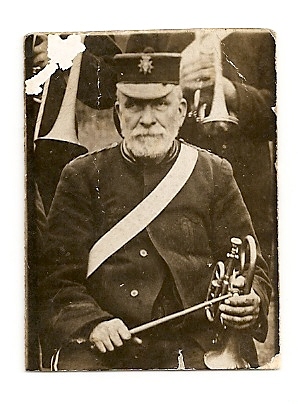
Tom Miller senior
Tom (sen.) was bandmaster, his eldest of five sons, Tom (Jun.) was secretary and H Kelham (Herbert, grandfather of H.T. (Tom)) was treasurer. In addition G Miller (George, the second son) and S Kelham (brother of Herbert presumably) were committee members. Mr. H Miller (Harry, the third son) was a member on trombone and it is likely that Arthur, the fourth son was a member, as a Master A. Miller was playing cornet in October 1891. Other members of the Miller and Kelham family are believed to have been members. It was very much a family band. The president was John Brooks, owner of a glove factory in the village.

Hathern Prize Band, 1890s, probably 1893. The second band
Back row: ?, Thos Miller (jnr), J. Brooks, ?, George Miller.
Middle row: Caleb Kelham, Herbert Widdowson Kelham, Tom Miller (snr), W. Tolllington, Mr. Beach, Henry (Harry) Miller.
Front row: Arthur Miller, Ernest Miller, Sam Kelham.
The reason why Tom Miller (sen.) had apparently left the original band to form a second one is not clear. However, there had been friction within the original band resulting in the departure of three (unknown) members. For on the 9th October, 1890, referring to a Sunday evening concert on the Round Bank, Wide Street, by the original brass band, it was reported that: ‘The village has long had a reputation of possessing a band of exceptional merit, but recently some unpleasantness had caused three members to leave’. We have no evidence however that these two events are connected. The new band was originally called the New Brass Band, but on 5th August 1893, it won third prize at a competition in Coalville and the name was changed to the Hathern Prize Band. It practised in the Temperance Hall, Pasture Lane – now the garage. The photograph above was taken opposite Stone House, Wide Street, and shows the Prize Band believed to be in 1890s, and could well have been taken following the 1893 competition.
Rivalry
In the meantime the original brass band had become the Old Brass Band. They were clearly anxious to add ‘Prize’ to their name, for they entered a number of competitions in the summer of 1894, for which they hired a conductor from Nottingham. On August 29th they were successful, coming second at Hinckley. They celebrated their success on Saturday 15th September by holding an invitation tea in the Co-op Hall followed by a procession round the village. The day ended with dancing at the Liberal Club (opened c.1886), the skittle alley of which was their practice room. Here the bandmaster, C. Moody, presented a silver baton to the conductor. They became the Old Prize Band, and are shown, somewhat later in 1903, in the photograph below.

The contest success of the Old Band led to the notorious case at the Loughborough Police Court in October, 1894, which involved the two bands. A member of the Old Prize Band was charged with being drunk and disorderly at the Hathern Cross on Saturday 22nd September and all the prosecution witnesses were members of the (new) Prize Band. The defence was based on the ‘jealousy’ between the two bands which brought into question the integrity of the prosecution witnesses including the ‘parish constable’ testifying to the defendant’s sobriety. Nevertheless, he was found guilty and fined 15 shillings.
There was clearly considerable animosity between the two bands. This appears to have been based on their political differences. The members of the Old Prize Band were members of the Liberal Club and most of them members of the Liberal Party. The (new) Prize Band was Conservative orientated. Despite this, the two bands paraded together on the occasion of Queen Victoria’s Diamond Jubilee, on the 22nd June 1897. The Old Prize Band led the procession followed by 400 children and then the Prize Band. ‘At several points the whole procession was drawn together and the combined bands played the National Anthem, under Fred Fuller’. There was dancing in the evening with ‘the bands rendering valuable service’. At Long Whatton, the celebrations were delayed because no band was available. Their parade took place two days later, led by the Hathern Prize Band under Tom Miller. The bands played together on at least one other occasion, which was the relief of Mafeking in May 1900 when they paraded the flag-bedecked village.
Tom Miller (sen.) died in May 1909 at the age of 69 ‘having been connected with the Hathern Bands ever since their formation dating back nearly 50 years’. ‘For about 20 years he was bandmaster of the Hathern Prize Band’. This would put the formation of the original band at just after 1859, but the ’50 years’ is too round a figure to be reliable. His son Tom took over the Prize Band.
Amalgamation, WW1 and WW2
In spite of their differences, the two bands amalgamated in mid 1917. This, apparently, was as a result of a strike at the Hathern Brick and Terra Cotta Co. (the Brickyard), which started in May 1917 as a result of the dismissal of four organisers of the Workers’ Union. A band was required to lead processions in support of the strikers. However, because of the demands of the war, neither band could muster a sufficient number of players and they consequently amalgamated. They became the Hathern United Prize Band. Tom Miller (jnr.) was conductor and Jimmy Fisher was bandmaster and principal cornet. Jimmy Fisher had been a prominent member of the Old Prize Band and can be seen in the 1903 photograph. The band practised at the Liberal Club. In the following months there were many parades and concerts given by the band both in aid of the war effort and also in support of the Brickyard strikers and their families.
Amalgamation appeared to have been beneficial to the band for, at a competition in Coalville on 27th October 1917, ‘a brass band quartette party from the Hathern United Prize Band’ won first prize out of eight bands. The players were J. Fisher, H. Kelham, H.W. Kelham and H. Miller with Tom Miller conducting. The Best Soloist prize was awarded to H.W. Kelham, the medal for which is shown below.
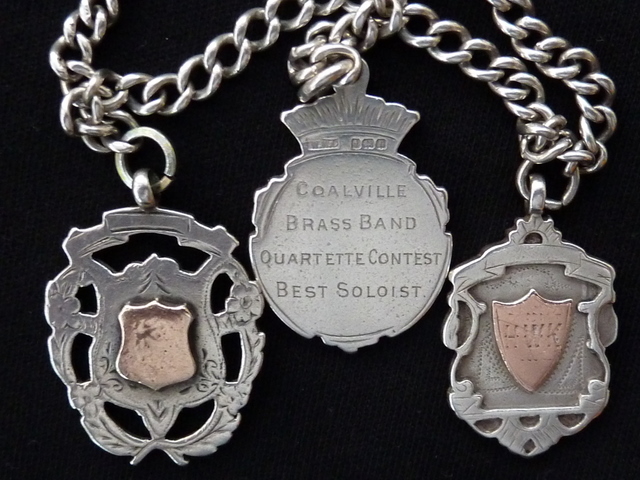
The band continued as the United Prize Band until July 1933, when it reverted to the Prize Band following the death of Jimmy Fisher in May. Tom Miller died in December 1935, at the age of 71 having remained conductor up to a week before his death. He had been with the band for 50 years.
Ernest Miller, fifth and youngest son of Tom Miller (sen.) then took over as bandmaster/conductor. He had joined the band in about 1930, having played with the Loughborough Band, whose conductor for a number of years around the time of the First World War had been fourth son Arthur Miller. Ernest was also conductor of the Hathern Adult School Orchestra from its formation in 1933 to its disbanding in 1939.
In the 1930s the band moved from the Liberal Club to the Three Crowns and then, in 1938, to the room above Swift’s factory on the (lower) Green, Hathern.
In 1937 professional conductors were engaged to conduct at engagements. Mr. T.F. Ward of Nottingham became professional conductor in 1937, having been engaged to train the band. He remained until mid 1940, when Mr. E. Radford took over. During the “phoney war” period, up to May 1940, little changed, but then the demands of war service began to take their toll, with many players leaving for war service, and there were no recorded engagement between 1942 and ’44. However, it seems likely that the older members kept a nucleus of a band together, since towards the end of the war, in mid July 1945, the band, still conducted by Mr. Radford, was in attendance at the Wakes Week parade and sports event, and also at the VJ celebrations in August 1945.

Alvaston Park, near Derby, September 1939
Back row: A. Henson, C. Brown, J.E. Miller.
Third row: J. Watt, H. Thornley, T. Dennis, L. Kelham, C. Ward, E. Miller, H.W. Kelham.
Second row: J. Aldridge, J. Iverson, W. Harbidge, A. Ward, T. Kelham, C. Kelham. Front row: J. Wortley, H. Webster.
The conductor was Frank Ward of Nottingham, who was not on the photograph.
Post War
After the war, Ernest Miller continued as conductor until 1950, remaining as bandmaster almost until his death in 1960.
Albert Kelham took over as conductor in 1950 having joined in the 1920s. He was the grandson of Herbert and son of Caleb. Caleb retired in 1956 after a long association with the band, having been either treasurer or secretary since the 1930s. Albert, whose son Dennis was also a member in the late 1950s, remained until 1959.
Ernest’s son J.E. (Jack) took over from his father, as bandmaster/chairman while W MacAnderson became conductor. Jack Miller had joined the band at about the same time as his father in 1930. He retired from the band in 1965 after 35 years as member, with the exception of the war years. During this time he had been variously secretary, deputy bandmaster and trustee. Jack was the last member of the Miller family in the band and thus a century old tradition had come to an end. Mac had joined the band just after the war and had been librarian and principal cornet for much of this time. He remained in the band until 1964 when he emigrated to Australia.
The 1960s and 1970s
By the late 1950s, the bandroom on the Green was proving inadequate and new premises were sought. Nothing suitable was found in Hathern and a room was eventually found at the Handicraft Centre, Garendon Rd, Shepshed, to where the band moved in 1960, retaining its name however. This was followed by Hall Croft school, which burnt down in 1977, when Hind Leys site was used.

Hathern Band, Shepshed c1960.
Back row: Albert Simons, R. Dawkins, D. Drummond, Geoff Fletcher, David Wright, Chris Watt, Alan Exon, Keith Unwin, Malcolm Gurkin, Roy Adkin, Tom Kelham, Ray Blood.
Middle row: Albert Reeves, Tim Hall, Michael Fletcher, Hayden Newton, Bill MacAnderson (Conductor), Ted Evans (President), Richard Wright, Peter Adams, Bernard Bennett, John Watt, Jack Miller.
Front row: John Brown, S. Richardson, A. Blood, Stuart Evans, Bob Parker, Peter Stanton, Trevor Unwin, R. Brown.
During the late 1950s and early 1960s the character of the band was changing significantly. The family band had all but disappeared, and a large number of new members had been recruited from Shepshed where the Shepshed band had ceased operation some time before. These, and the new post-war members, were succeeding to many of the main offices of the band.
Following Mac, a policy of employing expenses-paid conductors was adopted, although this had been done on occasions in the past, at least for engagements (1939 for example). Mr. A Hindmarch was conductor in 1965 and 1966 and Mr. K W Edwards from 1967 to 1970. It was with Keith Edwards that the band had its first major success in the National Brass Band Championships. In May 1969, it took first prize in the fourth section (of four sections) of the Midland Regional Qualifying Finals and subsequently competed in the National Finals in October at Hammersmith Town Hall in London, although the band did not achieve a place. This and other competition results are shown in the Results section of the website. This success was a remarkable achievement since membership had fallen to such a low level the year before that the band was in danger of closing, and the revival was mainly thanks to the efforts of chairman, Keith Unwin. It was in 1969 that the present name, Hathern Band, was adopted.

1969 National finalists, fourth section
Back row: Alan Blood, Greg Webber, Stuart Evans, Dave Baker, Frank Northage.
Middle row: Colin Garratt, John Blood, Richard Wright, R. Whitehall, Robert Parker, Tim Hall, John Watt, Steve Roulston, Pete Adams, Bernard Bennett, Anthony Lawrence.
Front row: Tom Kelham, David Wright, Malcolm Gurkin, Keith Unwin, Eric Blood, Keith Edwards, Roy Atkin, Dave Fletcher, Chris Watt, A. Wood, Haydon Newton.
Following this 1969 competition success the band was eventually promoted to the third section, although it returned to the fourth section in 1983. Mr. Fred Starky (1971–72), Mr. Burke (1973), Mr. G Gossage (1974-77) and Mr. R Blackett (1978-79) followed as conductor/musical director. The present musical director is Mr. D Newman who was appointed in 1979.
Tom, the last of the Kelham family in the band, retired in 1979 having joined in about 1927 or 28. His son, Les, joined just before the Second World War and played into the 1950s. With Tom’s departure another family association with the band lasting probably over a century came to an end.
The 1980s and 1990s
The 1980s saw a number of significant changes. In 1980, under chairman Mike Fletcher, the band moved back to Hathern, to the old school, after 20 years in Shepshed, and a decision was made to build a band-room in Hathern. In 1981 a junior band was formed, run by Peter Adams, which would to act as a feeder to the senior band.

Junior band on Loughborough Park, summer 1985
1984 saw the first contest success since 1969 in the National Brass Band Championships when 3rd place was achieved in the 4th section qualifying round. This led to representation at the Royal Albert Hall when a creditable 6th place was achieved. This was the last time that a lower section band played at this venue.
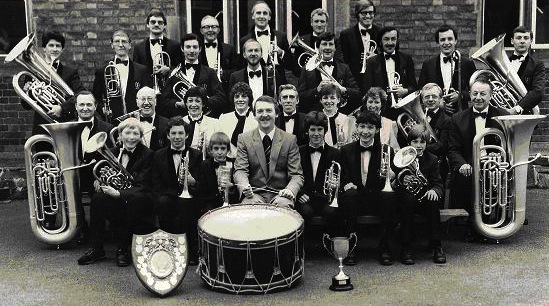
1984 National finalists, fourth section, at Hathern school
Back row: Gary Taylor, Jack Hartshorne, Colin Garratt, Stuart Evans, Geoff Fletcher.
Third row: Andrew Howarth, Alan Newman, Jeremy Pickard, Dave Curtiss, John Watt, Andrew Doughty, Mike Sturgess, Edward Atkin.
Second row: Roy Atkin, Keith Unwin, Lesley Bentley, Stephanie Harpham, Pete Adams, Karen Shackleton, Sharon Taylor, J Webb, Bill (JD) Baxter.
Front row: Chris Shore, Ian Bradford, Chris Brown, Dave Newman, Stuart Sharp, Nicholas Shore, James Fletcher.
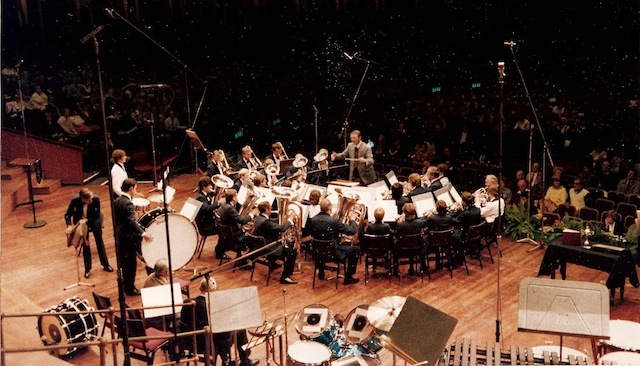
Royal Albert Hall, 1984
In 1985 the bandroom in Pasture Lane, Hathern was built. The shell was built professionally, but the fittings etc, including the trench for the electricity supply, were provided mainly by band members. It was opened by Philip McCann, the internationally renowned cornet player, on 24 August. The bandroom opening was the start of a long association with Philip, who has appeared as guest soloist at many of the band’s concerts. The bandroom was extended in August 1990 and again in May 1996, when the opening ceremony was performed by Stephen Dorrell MP.
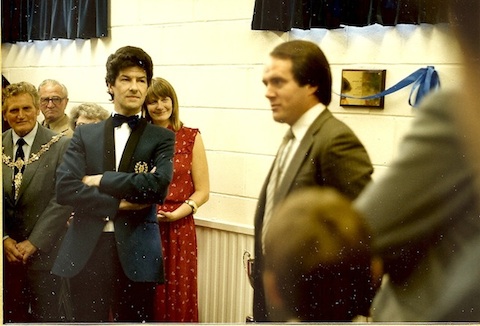
Band room opening, 24 August 1985, by Phillip McCann
1986 saw yet another representation in the fourth section of the National Finals, this time at Imperial College, London when a rather lowly 20th place was achieved. Following this, the band was promoted to the third section.
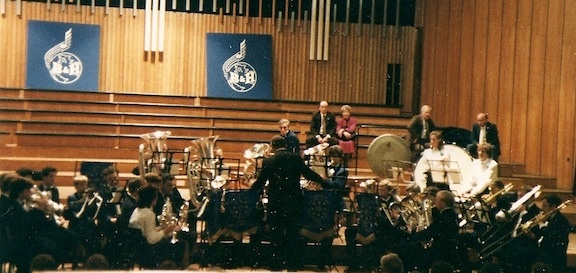
National Finals, Imperial College, 1986
A notable engagement of 1986 was the wedding in July of the daughter, Annabel, of Lord and Lady Elton in Sutton Bonington, when the band led a procession from the church, and played in the grounds of the Hall. The Secretary of State for Northern Ireland, Tom King, was a guest and the grounds were swarming with security staff.
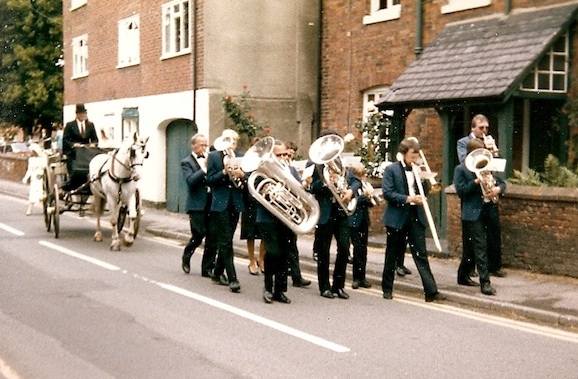
Hon Annabel Elton’s wedding, July 1986
In 1992, with an increasing number of bands in the national competition, five sections were introduced, which were, as in football: championship, first, second, third and fourth. Following a run of good results, the band was promoted to the first section (second tier) at this re-organisation.
In 1996 the band again qualified for the finals, this time in the first section, gaining second place to qualify, and 17th in the finals, held in Cardiff. Promotion to the championship section then followed, where the band remained for 2 years returning to the first section in 1999.
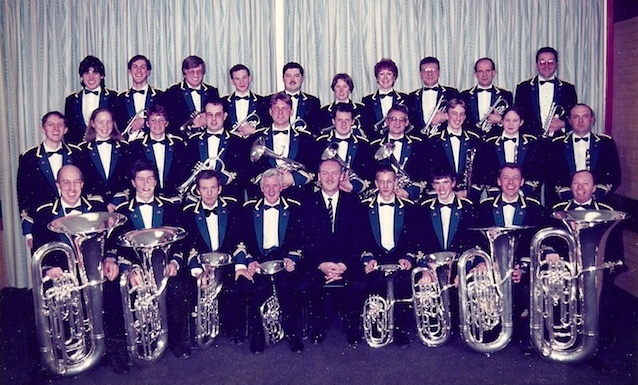
Hathern Band, March 1996, Nottingham
Back row: Matthew Ward, Stuart Croft, Geoff Fletcher, Kenny Powell, Mike Wood, Joanne Wood, Lesley Bentley, Tony Brown, Stuart Morgan, Geoff Wood.
Middle row: Jeremy Bowman, Joanne Price, Stephanie Harpham, Mark Tanser, John Beard, Bruce Harris, Gary Taylor, Adam Wright, Kate Williams, John Baum.
Front row: Martin Beniston, Andrew Haworth, Mike Allen, Stuart Evans, Dave Newman, Matthew Fletcher, Richard Ward, Edward Adkin, Alan Graham.
The nineties saw the introduction of a patrons scheme, started 1995, which continues to flourish, with about 125 members in 2009. For their patronage, patrons get a free concert with refreshments each year. The nineties also saw the start of a number of overseas visits. These generally took the form of a long weekend in which a number of concerts were given jointly with the host band, and there was usually a social or sight-seeing programme. In April 1991 the Dutch ONDA band of Middleburg, south-west Netherlands, was the host. In October of the following year, the ONDA band visited Hathern. During this visit, a joint concert was given at Stamford Hall, Loughborough. At the start, both national anthems were played, the Dutch one first, but unfortunately the audience didn’t recognise it and embarrassingly stood only when the British anthem was played.
During the Easter weekend of 1997, 28th to 31st March, the venue was Hillerød, in Denmark, about 20 miles north of Copenhagen, as guests of the Octava band. This visit was notable because of the appearance of Hale Bopp comet, which reached maximum brightness around the Easter period. Surely a good omen. The band were guests at a civic reception, seen below.
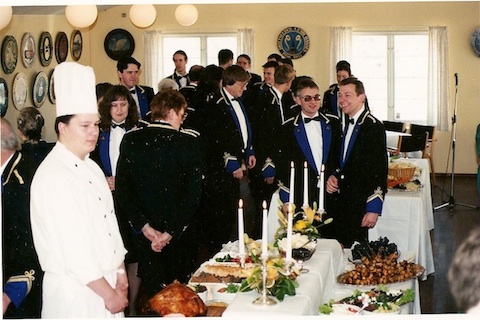
Civic reception, Hillerød, Denmark, 1997
2000 decade
The new century started off with two overseas visits. In April 2001, an invitation to Loughborough’s twin town Schwäbisch Hall, near Stuttgart, was accepted. The weather was very cold, with snow on the ground. Three concerts were given, one of which was in an open barn in a farm museum, when space heaters and schnapps had to be provided. There was also a concert given in the Rathaus (Town Hall), when a Chinese opera singer asked if she could sing an aria, with the band accompanying. With no rehearsal she sang “Che Faro” (“What is life without thee”), our only operatic aria available, producing a very powerful contralto voice from a very diminutive figure.
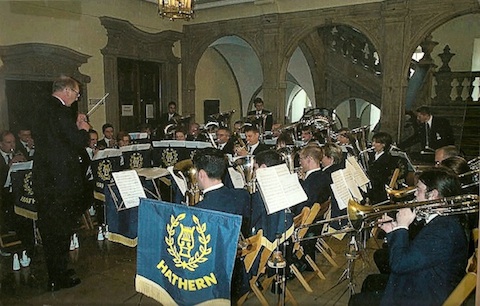
Schwäbisch Hall Rathaus (Town Hall), April 2001
In May 2002, a second visit was paid to the ONDA band to celebrate their 75th anniversary. On this occasion the band stayed in a hotel in Antwerp, and travelled by coach to functions in Middelburg.
The final overseas visit of the decade was to Belfast in June 2005, as guests of the First Old-Boys (SeaCat) band. Concerts were given at Belfast zoo and Carrickfergus castle, with a visit to the old Harland and Wolf shipyards, builders of the ‘Titanic’.
On the competition front, after a series of rather indifferent regional results, the band was demoted to the second section (3rd tier) for the 2004 season. However, this resulted in an unprecedented set of competition results, when the band won the regional competition and then the national finals in Harrogate, including best instrumentalist, becoming second section national champions.
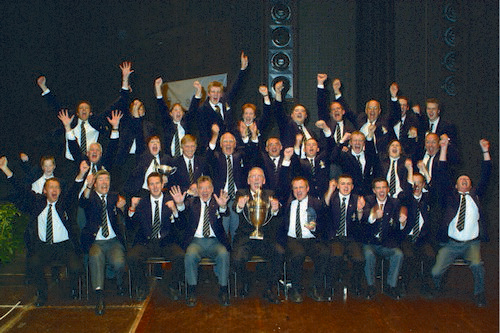
National Finals, Second Section Champions, September 2004
First place and best instrumentalist were then taken at two other competitions, to complete a most successful year. As a result of winning the finals, the band was promoted back to the first section. In 2008, third place was achieved in the regional competition (still first section), resulting in a second appearance at Harrogate, where 7th place was achieved.
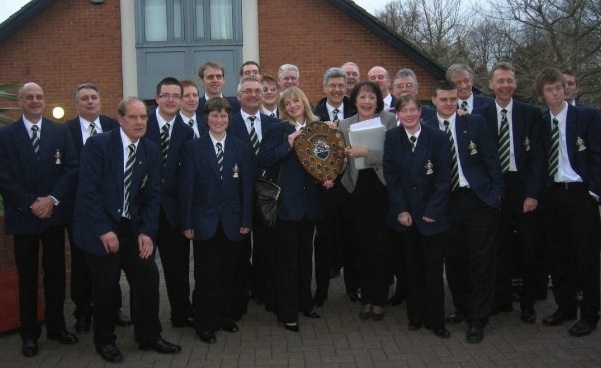
Regional Contest, Bedworth, March 2008
The decade saw a restructuring of the band organisation. The junior band, set up in 1981, had since become the “B” band, taking players of all ages and skills, and was giving concerts and entering competitions. The standard was consequently too high for learners. To fill the gap, a training band and youth band were formed. The training band, formed at the start of the decade, takes beginners who had been taught the basics. The youth band was formed in 2007 for players up to the age of 19; it is a contesting band, and its first competition was in 2008. At the same time the “B” band was renamed Concert Brass, and at present is a non-contesting band.
The new structure was the vision of the MD, David Newman, who conducted the training, youth and senior bands. 2009 was the 30th anniversary of his incumbency, during which time the band has appeared five times at the national finals (1984 and 1986 in 4th section, 1996 in 1st section, 2004 in 2nd section (becoming national champions) and 2008, 1st section). Additionally, there is a wall full of prize certificates and a cupboard full of silverware from other competitions (See results). In recognition of this achievement David was made honorary president of the band in October 2009, and thus became a band member. For the sake of completion, to the above list should be added the appearance at the finals, 4th section, in 1969, under Keith Edwards. This was the first time in Hathern’s history.
From the latter half of the decade, the band enjoyed Registered Charity status, and more financial details can be found on the Charity Commission website.
2010 decade
The band organisation, with its new structure, looked forward to the new decade, although a rather inauspicious start was made when only 13th place was achieved at the 2010 Regional qualifying competition. However, the band redeemed itself by taking second place the following year and qualifying for the national finals in the new venue at the Centaur, Cheltenham racecourse in September 2011, when a respectable 12th place of 18 contestants was achieved. Creditable results in the regional finals in 2012 and 2013 (4th and 5th) meant that the band was promoted to the Championship section for 2014, the first time since 1998. However, that section proved demanding, and the band returned to the 1st section for 2016. The band did well in that section and regained Championship status for 2018, only to be relegated for the 2020 season – a roller coaster six years. However, this decade has really seen the benefit of Hathern Band’s development ethos with a large proportion of the senior band now comprising players who first learnt to play in the training band.
Concert Brass is normally a non-contesting band but in 2014, under the direction of Andrea Allen, the band took part in the unregistered section at the Leicestershire Brass Band Association contest achieving a very creditable third place. In 2016, Chris Groom, formerly MD of Harborough Band, took over the baton from Andrea via Dean Onyon who stood in temporarily.
Andrew Haworth stood down as chair in 2011 with John Worsfold taking over the reins. In 2015, a quarterly newsletter was begun, plus a free “friends” organisation to go alongside the patrons’ scheme. Friends receive the newsletter and information about engagements.
In 2019, after 40 years, David Newman decided to retire as MD of the senior band. However, David remained as president and conductor of the training and youth bands. The band committee was delighted to appoint Lt. Col. Stephen Barnwell as the new musical director. Stephen progressed to becoming senior director of music for the Household Division before his retirement in 2013 and planned to relocate from London to Stanford on Soar.
The success of the band structure and player development meant that more youngsters wanted to learn to play. In addition, members of the band regularly visited schools to spread the word and attract new recruits. The result was that children had to learn in cramped conditions. A third extension to provide a new rehearsal room was needed and plans were duly made.
2020 decade
2020 will ever be remembered as the year of Covid, which had a serious effect on everyone connected with entertainment. Government guidance was always followed, and when band members could play together, it was outside in groups of six at first. Eventually, the bands could play indoors with necessary precautions and social distancing. The senior band’s first performance since January 2020 was at Oakham in August 2021. The pandemic upset many people’s plans, including those of Stephen Barnwell. He was not able to move in the foreseeable future so stood down as MD but will continue to work with the band as a musical advisor.
The positive step forward in those Covid days was that the planned extension was built in 2021 providing an excellent spacious room. Generous donations were received, and a local developer provided all the materials. Trombone player and retired builder, John Baum managed the project and patrons Gary Taylor and Mike Hale installed the electrics and decorated the room free of charge. At the 2021 Patrons’ Evening, John, Gary and Mike were made honorary patrons as was Brian Fletcher who retired as treasurer after over 20 years’ service.
Hathern Band goes from strength to strength as a village band that has achieved success in competition while never losing sight of the need to develop its own players and providing a band structure in which anyone can play. Credit for this is due to the foresight and commitment of David Newman. Of course, running and financing the band, particularly when it is self-supporting as at Hathern, which has no overall sponsor, is a tremendous feat of organisation. This has been achieved thanks to Lesley Bentley, who has been secretary or treasurer for the last few decades. Lesley is also Midlands Regional secretary and until 2021, Leicestershire Brass Band Association secretary as well. David Newman is also involved in the wider movement acting as vice chair of the Leicestershire Association. The band sees involvement in the community as an important part of its rationale, and it supports the LOROS hospice, donating the proceeds of its annual New Year concert, which are doubled by Barclays Bank. Over £42,000 has been raised in the twenty years to 2020.
